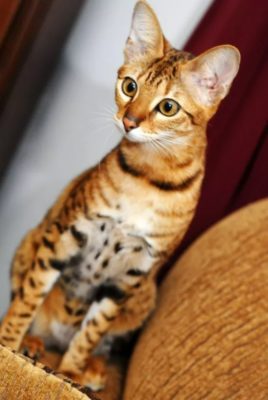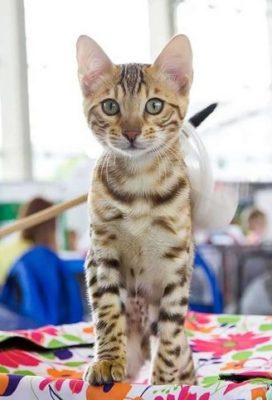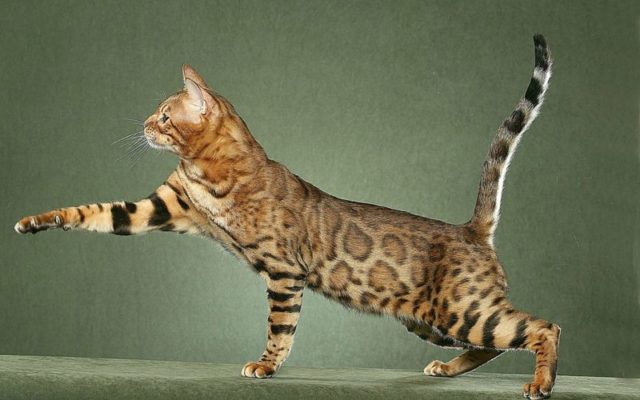Serengeti
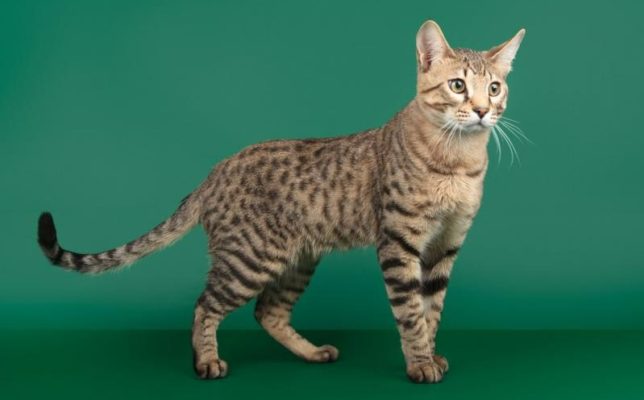
If we talk about the Serengeti character, the first thing to note is the activity and agility of this cat. Like wild cats, the Serengeti likes to spend time climbing on top of the climbing lodge or furniture. Cats like to rush around the house at breakneck speed, so you need to take care of the free space in the apartment.
Table of Contents
Breed Information
| Origin | United States |
| Size | Males 35-38 cm Females 32-35 cm |
| Weight | Males 12-15 kg Females 8-12 kg |
| Fur Type | Short-haired |
| Color | Golden or yellow with black spots, gray or white-silver with black spots |
| Lifestyle | Outdoors, indoors |
| Lifespan | 12-15 years |
| FIFe Classification | – |
| WCF Classification | – |
| TICA Classification | SE |
| Group | Short-haired cats, apartment cats (docile cats) |
| Price | $600-2000 |
Breed Photos
Origin History
The first Serengeti cat was created in the USA by breeder Karen Southman. She wanted to breed a breed that would artificially resemble the wild African serval without including the gene pool’s serval itself. To achieve the desired result, she crossed Oriental shorthair and Bengal cats. And the result was not long in coming – a kitten with a leopard skin color, unique spots, and a friendly temperament was born. The breed was named after the serval habitat – a geographic region that runs from the northwest of Tanzania to Kenya’s southwest. The name of this region is the Serengeti.
The Serengeti cat is often compared to the savannah cat; a breed descended from the African serval. Despite these similarities, the Serengeti has no wild blood. At the same time, it boasts the physique of a wild cat and a wild cat’s character. The Serengeti was created in 1994 and was registered by the International Cat Association as a “developing breed”.
Appearance
The Serengeti is a cat with a medium-sized backbone, long limbs, and large ears that make the head seem very small. Because of their long limbs, which are the longest of all domestic cats, these pets jump high and run fast. The eyes of the Serengeti are round and usually amber or gold in color. The gaze is penetrating and somewhat cold.
Because of the color of its coat, the Serengeti cat is very similar to the African serval. The cat’s fur is short and dense and has a silky texture. The color of this cat is usually golden or yellow with a print – widely spaced, distinct black spots, like a leopard. It is very rare to find a pure black Serengeti, gray or white-silver with black spots. The semi-transparent rods of the coat give the illusion of shimmering.
Character
If we talk about the Serengeti character, the first thing to note is the activity and agility of this cat. Like wild cats, the Serengeti likes to spend time climbing on top of the climbing lodge or furniture. Cats like to rush around the house at breakneck speed, so you need to take care of the free space in the apartment.
In addition to their energetic nature, Serengeti can be gentle and affectionate to their owner. They have proven to be a loving breed of cat that forms a very strong bond with people. The Serengeti is also very talkative, so you must be prepared to listen to her meow and purr almost around the clock.
Care
The Serengeti does not require any special care. This cat’s short and silky coat can be brushed once a week. It will not only help prevent baldness but will also keep the coat clean and healthy. Regular brushing also helps reduce the likelihood of hair clumps scattered around the apartment becoming a problem for family members. In addition to coat care, you should inspect your Serengeti’s ears for dirt buildup or possible infection every two weeks, brush their teeth regularly, and trim their claws.
The Serengeti is an adaptable cat that can do well in most climates, although it prefers higher temperatures. When temperatures rise, it is important to provide the cat with sufficient shade and freshwater to drink.
Education
Socialization and education of a kitten should begin at an early age – the earlier the pet learns the rules of conduct in the house, the fewer problems will have to be solved. Early education will avoid scratched furniture, ruined floors, and chewed shoes. To make fostering bring the kitten pleasure, you need to add interactive toys to the home environment.
The Serengeti is an active cat breed, so it needs plenty of room to run and climb in daily life. It is very important to keep the breed healthy and in good spirits; otherwise, feline obesity and frustration from boredom can become a problem for the cat.
Common Diseases
In general, Serengeti is a healthy cat, although that does not say that a vet visit is not necessary. Even if the pet is not sick, the vet should be regularly visited for preventive exams and wellness.
These cats are not prone to specific genetic diseases, but they are more prone than other cats to develop urolithiasis, mainly related to improper nutrition. The disease’s first symptoms include going to the litter box to no avail, meowing, and going to the toilet right in the middle of the apartment or in another inappropriate place. If these symptoms occur, you should immediately contact your veterinarian, prescribe treatment, and correct the diet.
Nutrition
Nutrition is an important part of the care of any cat, and the Serengeti is no exception. The nutrition of this breed should be dietary and balanced. This cat can be fed both industrial cat food and natural food, but certain rules must be followed in both cases.
If you do not want to bother, then industrial dry food or canned food is the best solution, but it is important to remember that these foods must be premium. Under no circumstances should you save money on your pet because it can negatively affect its health.
If the owner has enough time and energy to make Serengeti’s diet more varied, the choice should be made in favor of a natural diet. The diet’s basis should be lean meat – lean varieties of beef and veal, but in no case should you offer the cat pork. You should also not feed your cat sea fish and fermented dairy products.
 Highland Fold
Highland Fold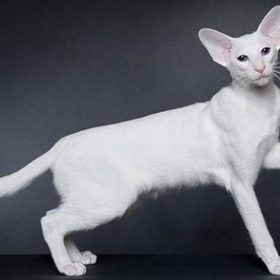 Foreign White
Foreign White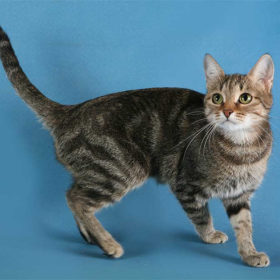 Brazilian Shorthair
Brazilian Shorthair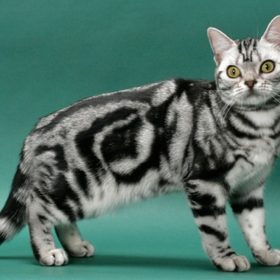 American Shorthair
American Shorthair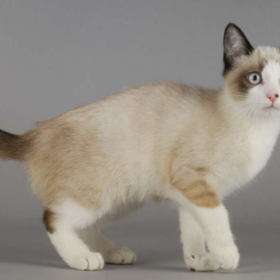 Snowshoe
Snowshoe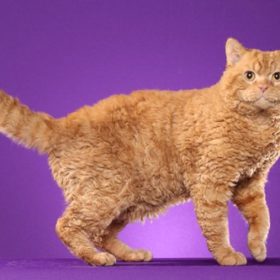 Selkirk Rex Shorthair
Selkirk Rex Shorthair